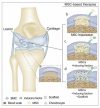Review of Synthetic and Hybrid Scaffolds in Cartilage Tissue Engineering
- PMID: 33212901
- PMCID: PMC7698415
- DOI: 10.3390/membranes10110348
Review of Synthetic and Hybrid Scaffolds in Cartilage Tissue Engineering
Abstract
Cartilage tissue is under extensive investigation in tissue engineering and regenerative medicine studies because of its limited regenerative potential. Currently, many scaffolds are undergoing scientific and clinical research. A key for appropriate scaffolding is the assurance of a temporary cellular environment that allows the cells to function as in native tissue. These scaffolds should meet the relevant requirements, including appropriate architecture and physicochemical and biological properties. This is necessary for proper cell growth, which is associated with the adequate regeneration of cartilage. This paper presents a review of the development of scaffolds from synthetic polymers and hybrid materials employed for the engineering of cartilage tissue and regenerative medicine. Initially, general information on articular cartilage and an overview of the clinical strategies for the treatment of cartilage defects are presented. Then, the requirements for scaffolds in regenerative medicine, materials intended for membranes, and methods for obtaining them are briefly described. We also describe the hybrid materials that combine the advantages of both synthetic and natural polymers, which provide better properties for the scaffold. The last part of the article is focused on scaffolds in cartilage tissue engineering that have been confirmed by undergoing preclinical and clinical tests.
Keywords: articular cartilage; cartilage tissue engineering; chondrocytes; materials for scaffolds; mesenchymal stem cells; regenerative medicine; scaffold obtaining methods; scaffold requirements; scaffolds; synthetic and hybrid scaffolds; tissue engineering.
Conflict of interest statement
The authors declare no conflict of interest in relation to the writing of this article.
Figures




Similar articles
-
Scaffolds for Cartilage Tissue Engineering from a Blend of Polyethersulfone and Polyurethane Polymers.Molecules. 2023 Apr 3;28(7):3195. doi: 10.3390/molecules28073195. Molecules. 2023. PMID: 37049957 Free PMC article.
-
Osteochondral Tissue Engineering Dilemma: Scaffolding Trends in Regenerative Medicine.Stem Cell Rev Rep. 2023 Aug;19(6):1615-1634. doi: 10.1007/s12015-023-10545-x. Epub 2023 Apr 19. Stem Cell Rev Rep. 2023. PMID: 37074547 Review.
-
Biomimetic poly(glycerol sebacate)/polycaprolactone blend scaffolds for cartilage tissue engineering.J Mater Sci Mater Med. 2019 Apr 29;30(5):53. doi: 10.1007/s10856-019-6257-3. J Mater Sci Mater Med. 2019. PMID: 31037512
-
Cartilage Tissue Regeneration: The Roles of Cells, Stimulating Factors and Scaffolds.Curr Stem Cell Res Ther. 2018;13(7):547-567. doi: 10.2174/1574888X12666170608080722. Curr Stem Cell Res Ther. 2018. PMID: 28595567 Review.
-
Collagen Scaffolds in Cartilage Tissue Engineering and Relevant Approaches for Future Development.Tissue Eng Regen Med. 2018 Jul 25;15(6):673-697. doi: 10.1007/s13770-018-0135-9. eCollection 2018 Dec. Tissue Eng Regen Med. 2018. PMID: 30603588 Free PMC article. Review.
Cited by
-
Does vehicle-based delivery of mesenchymal stromal cells give superior results in knee osteoarthritis? Meta-analysis of randomized controlled trials.J Clin Orthop Trauma. 2022 Jan 19;25:101772. doi: 10.1016/j.jcot.2022.101772. eCollection 2022 Feb. J Clin Orthop Trauma. 2022. PMID: 35127439 Free PMC article. Review.
-
Scaffolds for Cartilage Tissue Engineering from a Blend of Polyethersulfone and Polyurethane Polymers.Molecules. 2023 Apr 3;28(7):3195. doi: 10.3390/molecules28073195. Molecules. 2023. PMID: 37049957 Free PMC article.
-
Smart injectable hydrogels for periodontal regeneration: Recent advancements in biomaterials and biofabrication strategies.Mater Today Bio. 2025 May 11;32:101855. doi: 10.1016/j.mtbio.2025.101855. eCollection 2025 Jun. Mater Today Bio. 2025. PMID: 40487163 Free PMC article. Review.
-
Application of decellularization methods for scaffold production: advantages, disadvantages, biosafety and modifications.Front Bioeng Biotechnol. 2025 Jun 18;13:1621641. doi: 10.3389/fbioe.2025.1621641. eCollection 2025. Front Bioeng Biotechnol. 2025. PMID: 40606910 Free PMC article. Review.
-
A Review of the Role of Bioreactors for iPSCs-Based Tissue-Engineered Articular Cartilage.Tissue Eng Regen Med. 2023 Dec;20(7):1041-1052. doi: 10.1007/s13770-023-00573-6. Epub 2023 Oct 20. Tissue Eng Regen Med. 2023. PMID: 37861960 Free PMC article. Review.
References
-
- Yan Q., Dong H., Su J., Han J., Song B., Wei Q., Shi Y. A Review of 3D Printing Technology for Medical Applications. Engineering. 2018;4:729–742. doi: 10.1016/j.eng.2018.07.021. - DOI
Publication types
LinkOut - more resources
Full Text Sources

